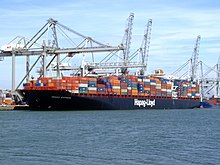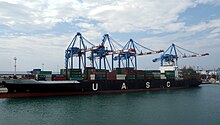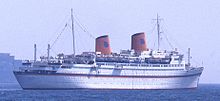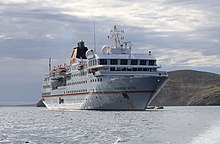
Hapag-Lloyd

 | |
| Company type | Public (AG) |
|---|---|
| FWB: HLAG | |
| ISIN | DE000HLAG475 |
| Industry | |
| Founded | 1 September 1970 |
| Founders | Adolph Godeffroy Ferdinand Laeisz Carl Woermann August Bolten (HAPAG) Hermann Henrich Meier (Norddeutscher Lloyd) (all founded in 1800s) |
| Headquarters | , |
Area served | Worldwide |
Key people |
|
| Products | Cargo shipping |
| Revenue | |
| Total assets | |
| Total equity | |
Number of employees | 16,295[2] |
| Website | hapag-lloyd |
Hapag-Lloyd AG is a German international shipping and container transportation company, the 5th biggest in the world.[3] It was formed in 1970 through a merger of Hamburg-American Line (HAPAG) and Norddeutscher Lloyd.[4]


History
The company was formed on 1 September 1970, by the merger of two German transportation/maritime companies, Hamburg-American Line (HAPAG), founded in 1847, and Norddeutscher Lloyd (known in English as North German Lloyd), which was formed in 1857.

Since its formation, Hapag-Lloyd has seen changes among its shareholders and has also undergone a number of mergers with other companies. For instance, Hapag-Lloyd was completely acquired by, and became a subsidiary of TUI AG (Hanover) in 1998. This transition was followed by TUI selling a majority stake of Hapag-Lloyd to private investors in Hamburg in 2009 and further sales in 2012. Other important events in the history of the company include Hapag-Lloyd's acquisition of CP Ships in 2005 as well as Hapag-Lloyd's merger with the container business of CSAV in 2014, and United Arab Shipping Company in 2017.

HAPAG

The Hamburg-Amerikanische Packetfahrt-Actien-Gesellschaft for shipping across the Atlantic Ocean was founded in Hamburg. In 1912, Hapag built the first of their "Big Three" ocean liners; the Imperator, followed by its twin Vaterland. A third twin, Bismarck, was under construction at the outbreak of World War I and was completed after the war for White Star Line as the Majestic. These were the first liners to exceed 50,000 gross register tons and 900 feet (274 m) in length. During World War I, the majority of Hapag's fleet of 175 ships were wiped out, and most of the surviving ships (including the "Big Three") had to be turned over to the winning side as war reparations. After the war's end, Hapag rebuilt its fleet with much smaller ships than before the war, but their fleet was again mostly wiped out during World War II, and the surviving ships turned over to Allied powers.[5]

Norddeutscher Lloyd


Norddeutscher Lloyd (NDL) was formed in 1857 in the City-State of Bremen, offering passenger and cargo transportation between Bremen and New York, with an emphasis on emigration to the United States. Service started in June 1858 with the Bremen, the first of four steamships,[6] and the company established its American base at Hoboken, New Jersey. NDL eventually built a large fleet of ships that carried many thousands of emigrants westwards, with around 218,000 passengers transported across the Atlantic in 1913 alone.[7]

The outbreak of World War I resulted in the internment of 32 vessels in US ports, a status later changed to confiscation when the US entered the war in 1917.[8] Likewise, its Hoboken base was confiscated and turned over to the US Navy, which used it as a transshipping point for the duration of the war.[9] As with HAPAG, those NDL ships surviving the war were eventually confiscated as reparation, leaving the company to start over from scratch.

US operations were resumed in 1922, when NDL was able to purchase its former base from the United States Alien Property Administrator.[citation needed] NDL launched a new Bremen and Europa in 1929–30.[9]

During World War II, NDL repeated its World War I experience, with some parts of its fleet again being interned at the outbreak of the war, while a number of vessels remained under NDL control.[10] One such exception was the Bremen, which raced across the Atlantic, and achieved protection at Murmansk in 1939, before eventually making a dash for Bremerhaven, where she was ultimately destroyed by a fire in 1941.[11]

Passenger service resumed in 1954 with the Gripsholm formerly belonging to the Swedish American Line (the ship was renamed to MS Berlin only the following year).[12] Later two other second-hand ships, SS Bremen (formerly Pasteur) and MS Europa (formerly Swedish American Line's Kungsholm), were purchased.[9]

NDL attained several speed records over the years. Notable among them was the record for the run between Southampton and New York of eight days in 1881, which was set by the Elbe; and the record for the fastest transatlantic crossing set by the new Bremen in 1929 (see Blue Riband).[9]

Hapag-Lloyd

Hapag and NDL continued to compete until they established a joint-venture container line. The "Hapag-Lloyd Container Line", founded in 1967 and operating from 1968 onward, was established to share the huge investments related to the containerisation of the fleets. The two companies finally merged on 1 September 1970, under the name Hapag-Lloyd.[4]

Hapag-Lloyd was acquired in 1998 by Preussag AG (since 2002 named TUI AG (Hanover)), a tourism conglomerate, and became its fully-owned subsidiary in 2002.[13]

In August 2008, TUI announced an intention to sell its entire stake in Hapag-Lloyd shipping activities before the end of that year. Industry speculation predicted a sale price of approximately US$5.9 billion.[14]

In October 2019, Hapag-Lloyd acquired a 10 percent stake in Container Terminal 3 (TC3) of the Tangier Med 2 port in Morocco.[15][16]

In April 2022, Hapag-Lloyd acquired a participation in JadeWeserPort Wilhelmshaven, taking ownership of a 30 percent stake in Container Terminal Wilhellmshaven (CTW) and a 50 percent stake in Rail Terminal Wilhelmshaven (RTW).[17]

On 12 January 2023, Hapag-Lloyd acquired a 49% minority stake in Spinelli Group, an Italian terminal and transport operator.[18] Around three months later, on 19 April 2023, Hapag-Lloyd also acquired a 40% stake in J M Baxi Ports & Logistics Limited (JMBPL), a terminal and inland transport service provider in India.[19]

In August 2023, it was announced Hapag-Lloyd had acquired SM SAAM's terminal business and related logistics services in the Americas.[20] Since then, Hapag-Lloyd's business activities have been divided into the segments of Liner Shipping on the one hand and Terminal & Infrastructure on the other.[21] The Terminal & Infrastructure division has been operating under the brand name “Hanseatic Global Terminals” since July 2024. It is a fully owned but independent stand-alone business unit based in Rotterdam.[22]

Also in 2023, Hapag-Lloyd and the Brazilian shipping and waterway logistics company Norsul set up a new joint venture called “Norcoast”. Based on a 50-50 partnership, Norcoast started offering container cabotage and feeder services in Brazilian ports in the first quarter of 2024.[23]

Mergers and acquisitions
CP Ships Limited
On 21 August 2005, TUI AG agreed to acquire the Canadian business CP Ships Limited for €1.7 billion (US$2.0 billion) in cash. The deal, which was approved by the boards of both CP Ships, TUI, and the shareholders, was a success, and made the combined fleet the fifth-largest by capacity in the worldwide container shipping market.[24][25]


Hamburg Süd
In late 2012, Hapag-Lloyd announced it was considering the possibility of a merger with its smaller compatriot Hamburg Süd. The merger plans were scotched when Hamburg Süd's shareholders and owners did not reach an agreement with the Hapag-Lloyd stakeholders.[26] After this event, Hamburg Süd remained a private, independent company until December 2016, when the container transport division of Danish logistics and energy company Maersk, announced it would purchase Hamburg Süd.[27]

Compañía Sud Americana de Vapores (CSAV)
In 2014, Hapag-Lloyd took over the container business of Chile's Compañía Sud Americana de Vapores SA (CSAV), with the latter becoming a major shareholder of Hapag-Lloyd. This made Hapag-Lloyd the fourth-largest container-shipping company in the world at the time.[28][29]

United Arab Shipping Company (UASC)
In April 2016, Hapag-Lloyd announced it was in merger talks with the United Arab Shipping Company (UASC). The merger was agreed upon later in 2016, and the integration between the two companies was completed in 2017. At the time of the merger, UASC was reported to be the world's 10th largest liner shipping company, with a fleet of 56 ships and a market share of 2.7 percent.[30] As a result of the merger, Hapag-Lloyd strengthened its position as the world's fifth-largest container transporter in terms of vessel capacity, ahead of Taiwan's Evergreen Line. As a result of the merger, the former shareholders of UASC would become the largest shareholder in the new entity, whilst Hapag-Lloyd would absorb all operations and assets of UASC.[31]


Historically United Arab Shipping Company was jointly established in July 1976 by the six shareholding governments of the Arab states of the Gulf (Bahrain, Iraq, Kuwait, Qatar, Saudi Arabia and UAE).[32] Originally based in Kuwait, its corporate headquarters then moved to Dubai during the Iraqi conflict, and only some departments were moved back after the war.[33]

The UASC fleet operated more than 45 services, connecting the Middle East to Europe, the Mediterranean, Indian Sub-continent, Far East, West Africa and the Americas.[34] Its network covered over 220 ports, offering containerized and conventional cargo shipping by a fleet of 58 owned and chartered vessels.[35] On 29 June 2016, UASC's six shareholding states voted unanimously to approve the proposed merger. The deal gave a relative valuation of the two businesses at 72 percent for Hapag-Lloyd and 28 percent for UASC. At the time of the merger, UASC was 51 percent owned by Qatar and 35 percent owned by Saudi Arabia government, with the remainder held by other Arab states.[36]

NileDutch Transport & Shipping
In March 2021, Hapag-Lloyd announced the acquisition of Nile Dutch Investments B.V., a leading container service provider to and from West Africa.[37] The transaction was effectively closed on 8 July 2021.[38]

Deutsche Afrika-Linien
On 1 June 2022, Hapag-Lloyd closed the acquisition of the container liner business of German carrier Deutsche Afrika-Linien (DAL), another Africa specialist, operating with liner services between Europe, South Africa and the Indian Ocean.[39]

Hapag-Lloyd Cruises and business areas
Container transportation
- Hapag-Lloyd transports containerized cargo on several major trade routes around the world. It has a prominent market presence and brand recognition in Latin America, Middle East, trans-Atlantic, and trans-Pacific trades, among others.[40]
- Hapag-Lloyd is currently the largest member of the Transport High Efficiency vessel-slot sharing alliance ("THE Alliance"), which was created in April 2017 and also includes Taiwan's Yang Ming Line, Korea's HMM and the Japanese carrier Ocean Network Express (ONE).[41][42] THE Alliance covers East-Westbound trades with 255 container ships and 29 services.[42]
Hapag-Lloyd Kreuzfahrten
Hapag-Lloyd Kreuzfahrten was a former cruise ship subsidiary of Hapag-Lloyd AG. In 2008, TUI AG integrated Hapag-Lloyd Kreuzfahrten. It was renamed Hapag-Lloyd Cruises in 2016. In 2020, Hapag-Lloyd Kreuzfahrten was sold to TUI Cruises, a joint venture between TUI and Royal Caribbean.[43] Only vessels formerly operated by Hapag-Lloyd AG are listed here.

Current Fleet
| Name | Built | Tonnage | In service for HAPAG-LLOYD Cruises | Image |
|---|---|---|---|---|
| Europa I aka Europa | 1999 | 28,890 GT | 1999–Present |  |
| Europa II | 2013 | 42,830 GT | 2013–Present |  |
| Hanseatic Nature | 2019 | 2019–Present |  | |
| Hanseatic Inspiration | 2019 | 2019–Present |  | |
| Hanseatic Spirit | 2021 | 2021–Present |  |
Former Fleet
| Name | Built | Tonnage | In service for HAPAG-LLOYD Cruises | Image |
|---|---|---|---|---|
| Bremen | 1938 | 32,360 GRT | 1970-1971 |  |
| Europa | 1952 | 21,164 GRT | 1970-1981 |  |
| Finnstar | 1967 | 8,583 GRT | 1979-1980 | |
| Europa | 1981 | 37,049 GT | 1981-1999 |  |
| Bremen | 1990 | 6,752 GT | 1993-2021 |  |
| Hanseatic | 1993 | 8,445 GT | 1996-2018 |  |
| Columbus | 1997 | 15,067 GT | 1997-2012 |  |
| Columbus 2 | 1998 | 30,277 | 2012-2014 |  |
Airline activities
Hapag-Lloyd founded the charter airline Hapag-Lloyd Flug in 1972, buying a few Boeing 727s to fly its cruise passengers from Germany to the cruises' ports of call. The airline eventually added some regular passenger flights as well. Hapag-Lloyd Flug used the IATA code HF and became a directly owned subsidiary of Preussag AG (now renamed as TUI Group) in 1999.[44]

Fleet
| Ship class | Built | Capacity (TEU) | Ships in class | Notes |
|---|---|---|---|---|
| Hamburg Express-class | 2012–2014 | 13,177 | 10 | |
| A13-class | 2011–2012 | 13,296 | 9 | Originally built for the United Arab Shipping Company (UASC) |
| A15-class | 2014–2017 | 14,993 | 11 | Originally built for the United Arab Shipping Company (UASC) |
| A18-class | 2015–2016 | 19,870 | 6 | Originally built for the United Arab Shipping Company (UASC) |
| Valparaiso Express-class | 2016–2017 | 11,519 | 5 | |
| Hamburg Express-class | 2023–onwards | 23,664 | 12 | Built at Hanwha Ocean[45][46] (formerly Daewoo Shipbuilding & Marine Engineering) |
Some emblematic group's vessels are:


- MS München (1972)
- Tokio Express (1973)
- Yantian Express (2012), formerly Shanghai Express (2002)
- Houston Express (2005)
- Savannah Express (2005)
- Colombo Express (2005)
- Kyoto Express (2005)
- Chicago Express (2006)
- Osaka Express (2007)
- Tsingtao Express (2007)
- Hong Kong Express (2013)
Accidents and incidents
Colombo Express
On 29 September 2014, the container ship Colombo Express was involved in a collision with the container ship Maersk Tanjong, and sustained a 20-metre (65 ft) dent to its left side and caused delays to traffic through the Suez Canal.[47]

See also
References
- ^ "Login - DVZ".
- ^ a b c d e f "Hapag Lloyd Investor Report 2023" (PDF). Hapag-Lloyd AG. p. 2. Retrieved 1 May 2022.
- ^ "Fortune Global 500 – the largest companies in the world by revenue".
- ^ a b "Hapag-Lloyd". Castles of the Seas. Archived from the original on 18 February 2020. Retrieved 22 September 2019.
- ^ "Hamburg America Line". Ships List. Archived from the original on 25 May 2011. Retrieved 22 September 2019.
- ^ Kludas, Arnold (1991). Die Seeschiffe des Norddeutschen Lloyd 1857 bis 1919, Vol. 1. Herford. p. 10.
{{cite book}}: CS1 maint: location missing publisher (link) - ^ Drechsel, Edwin (1994). Norddeutscher Lloyd Bremen 1857–1970: History, Fleet, Ship Mails. Vol. I. Vancouver: Cordillera Pub. Co. p. 410.
- ^ Drechsel, Edwin (1994). Norddeutscher Lloyd Bremen 1857–1970: History, Fleet, Ship Mails. Vol. II. Vancouver: Cordillera Pub. Co. p. 1.
- ^ a b c d Kenneth T. Jackson (1995). The Encyclopedia of New York City. New-York Historical Society; Yale University Press. p. 854.
- ^ NDL Annual Report 1939–1948. p. 4.
- ^ Huchthausen, Peter A. (2005). Shadow Voyage: The Extraordinary Wartime Escape of the Legendary SS Bremen. Hoboken, N.J.: J. Wiley & Sons. ISBN 0-471-45758-2. OCLC 55764562.
- ^ Drechsel, Edwin (1995). Norddeutscher Lloyd. Vol. II. Vancouver. p. 493.
{{cite book}}: CS1 maint: location missing publisher (link) - ^ "Hapag-Lloyd CEO: reduction in operational costs needed" (Archived 29 June 2017 at the Wayback Machine), Arabian Supply Chain, 30 March 2015. Accessed 23 July 2015.
- ^ "Hapag-Lloyd sales rise as Tui confirms shipping exit plans". Lloyd's List Daily Commercial News. Informa Australia. 15 August 2008. Retrieved 15 August 2008.[permanent dead link]
- ^ "Hapag-Lloyd acquires stake in Moroccan terminal - Hapag-Lloyd". www.hapag-lloyd.com. 2 December 2019. Archived from the original on 5 February 2021. Retrieved 4 December 2020.
- ^ Bouhrara, par Imane (31 October 2019). "Marsa Maroc : Hapag-Lloyd AG désormais actionnaire de Tanger Alliance" (in French). Archived from the original on 15 February 2022. Retrieved 24 September 2021.
- ^ "EU Commission gives green light for Hapag-Lloyd participation in JadeWeserPort". 29 April 2022. Retrieved 14 December 2022.
- ^ "Hapag-Lloyd acquires stake in the Spinelli Group". 12 January 2023. Retrieved 25 May 2023.
- ^ "Share acquisition in J M Baxi Ports & Logistics Limited successfully concluded". 19 April 2023. Retrieved 25 May 2023.
- ^ "Hapag-Lloyd successfully completes acquisition of SM SAAM terminal business". Retrieved 3 August 2023.
- ^ Hapag-Lloyd AG, Quarterly financial report 1 January to 30 September 2023, p. 3.
- ^ "Hanseatic Global Terminals: A new brand to strengthen and expand the terminal business". 1 July 2024. Retrieved 11 December 2024.
- ^ Hapag-Lloyd and Norsul to launch new joint venture company for cabotage business in Brazil. Retrieved 22 November 2023.
- ^ Bienk, Kirsten (22 August 2005). "TUI Offers To Buy CP Ships". money.cnn.com. Archived from the original on 15 May 2022. Retrieved 15 May 2022.
- ^ Singer, Jason (20 August 2005). "Germany's TUI to Acquire CP Ships in $2 Billion Deal". Wall Street Journal. ISSN 0099-9660. Archived from the original on 15 May 2022. Retrieved 15 May 2022.
- ^ "Hapag-Lloyd merger with Hamburg-Sued called off". Reuters. 24 March 2013. Archived from the original on 22 September 2019. Retrieved 22 September 2019 – via uk.reuters.com.
- ^ "Oetker group sells shipping business to Maersk | DW | 01.12.2016". DW.COM. Archived from the original on 8 November 2020. Retrieved 22 September 2019.
- ^ "Regulators clear way for merger of Hapag-Lloyd and Vapores". Reuters. 2 December 2014. Archived from the original on 24 September 2015. Retrieved 2 December 2014.
- ^ "Approval for World's Fourth Largest Container Shipping Line Granted Archived 28 October 2020 at the Wayback Machine" Handy Shipping Guide, 2 December 2014. Accessed: 12 December 2014
- ^ Barki, Deniz; Délèze-Black, Lucy, eds. (2017). Review of Maritime Transport 2017 (PDF). New York: United Nations Conference on Trade and Development (UNCTAD). p. 30. ISBN 978-92-1-362808-9. Archived (PDF) from the original on 6 August 2020. Retrieved 16 March 2018.
The Review of Maritime Transport 2017 covers data and events from January 2016 until June 2017. (p. viii)
- ^ "Talks between Hapag-Lloyd and United Arab Shipping Company". 21 April 2016. Archived from the original on 26 May 2016. Retrieved 26 May 2016.
- ^ "United Arab Shipping joins the frontline as other shipping companies retreat". The Express Tribune. 16 December 2012. Archived from the original on 23 October 2018. Retrieved 23 October 2018.
- ^ "UASC MOVING BACK TO KUWAIT SOME DIVISIONS TO STAY IN DUBAI". www.joc.com. 30 June 1992. Archived from the original on 15 May 2022. Retrieved 22 September 2019.
- ^ "Hapag-Lloyd Investor Presentation" (PDF). Archived (PDF) from the original on 6 December 2019. Retrieved 6 December 2019.
- ^ "UASC signs USD 2.5 bln deal with Hyundai". Shipping Watch. 30 August 2013. Archived from the original on 15 May 2022. Retrieved 21 September 2019.
- ^ Lo, Joe (1 July 2016). "UASC and Hapag-Lloyd's merger progresses". Archived from the original on 23 October 2018. Retrieved 23 October 2018.
- ^ "Hapag-Lloyd acquires Africa specialist NileDutch". Archived from the original on 17 March 2021. Retrieved 22 March 2021.
- ^ "Hapag-Lloyd acquires Africa carrier NileDutch - Hapag-Lloyd". www.hapag-lloyd.com. 8 July 2021. Archived from the original on 24 September 2021. Retrieved 24 September 2021.
- ^ "Hapag-Lloyd acquires container liner business of Africa specialist Deutsche Afrika-Linien (DAL)". June 2022. Retrieved 14 December 2022.
- ^ "About us - Hapag-Lloyd". www.hapag-lloyd.com. Archived from the original on 24 April 2021. Retrieved 6 April 2021.
- ^ "Hapag-Lloyd and Asian lines form six-member alliance". Lloyd's List. 13 May 2016. Archived from the original on 9 August 2017. Retrieved 9 August 2017.
- ^ a b Hapag-Lloyd AG, Annual Report 2022. p. 74.
- ^ "TUI Group: Sale of Hapag-Lloyd Cruises to TUI Cruises completed". www.tuigroup.com. Archived from the original on 15 January 2021. Retrieved 2 February 2021.
- ^ "Facts and Figures." Hapagfly. 1 June 2005. Retrieved on 29 May 2009.
- ^ "Hapag-Lloyd orders six ultra large container vessels of 23,500+ TEU - Hapag-Lloyd". www.hapag-lloyd.com. 23 December 2020. Archived from the original on 31 December 2020. Retrieved 7 April 2021.
- ^ "Hapag-Lloyd repeats an order of six ULCVs". Container News. 22 June 2021. Archived from the original on 28 June 2021. Retrieved 28 June 2021.
- ^ "Containerships collide near entrance to Suez Canal". FreightWaves. 2 March 2019. Archived from the original on 3 May 2021. Retrieved 3 May 2021.
Further reading
- Susanne Wiborg and Klaus Wiborg: The World Ist Our Oyster – 150 Years of Hapag-Lloyd 1847–1997. Hapag-Lloyd AG (ed.), Hamburg 1997.
- Kai-Axel Aanderud: 175 Jahre Hapag-Lloyd – 175 Years of Hapag-Lloyd 1847–2022: Vom Auswandererschiff zum Megacarrier – From emigrant ship to megacarrier. Hamburg: Koehler. 2022. ISBN 978-3-7822-1500-8.
External links
See what we do next...
OR
By submitting your email or phone number, you're giving mschf permission to send you email and/or recurring marketing texts. Data rates may apply. Text stop to cancel, help for help.
Success: You're subscribed now !
